





 Starting position on a 10x10 draughts board
|
|
| Genre(s) | Board game Abstract strategy game |
|---|---|
| Players | 2 |
| Random chance | None |
| Skill(s) required | Strategy, tactics |
| Synonym(s) | Chequers Checkers |
Draughts (UK ) or checkers (American English) is a group of strategy board games for two players which involve diagonal moves of uniform game pieces and mandatory captures by jumping over opponent pieces. Draughts developed from alquerque. The name derives from the verb to draw or to move.
The most popular forms are English draughts, also called American checkers, played on an 8x8 checkerboard; Russian draughts, also played on an 8x8; and international draughts, played on a 10x10 board. There are many other variants played on an 8x8, and Canadian checkers is played on a 12x12 board.
Draughts (or checkers) is played by two opponents, on opposite sides of the gameboard. One player has the dark pieces; the other has the light pieces. Players alternate turns. A player may not move an opponent's piece. A move consists of moving a piece diagonally to an adjacent unoccupied square. If the adjacent square contains an opponent's piece, and the square immediately beyond it is vacant, the piece may be captured (and removed from the game) by jumping over it.
Only the dark squares of the checkered board are used. A piece may move only diagonally into an unoccupied square. Capturing is mandatory in most official rules, although some rule variations make capturing optional when presented. In almost all variants, the player without pieces remaining, or who cannot move due to being blocked, loses the game.
Uncrowned pieces (men) move one step diagonally forward, and capture an opponent's piece by moving two consecutive steps in the same line, jumping over the piece on the first step. Multiple opposing pieces may be captured in a single turn provided this is done by successive jumps made by a single piece; the jumps do not need to be in the same line but may "zigzag" (change diagonal direction). In English draughts men can capture only forward, but in international draughts and Russian draughts they may also capture (diagonally) backwards.
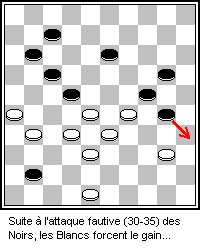 A game in international draughts, featuring a flying king
A game in international draughts, featuring a flying kingWhen a man reaches the crownhead or kings row (the farthest row forward), it becomes a king, and is marked by placing an additional piece on top of the first man, and acquires additional powers including the ability to move backwards (and capture backwards, in variants in which they cannot already do so). As with non-king men, a king may make successive jumps in a single turn provided that each jump captures an opponent man or king.
In international draughts, kings (sometimes called flying kings) move any distance along unblocked diagonals, and may capture an opposing man any distance away by jumping to any of the unoccupied squares immediately beyond it. Since captured pieces remain on the board until the turn is complete, it is possible to reach a position in a multi-capture move where the flying king is blocked from capturing further by a piece already captured.
Flying kings are not used in English draughts, in which a king's only advantage over a man is the ability to move and capture backwards as well as forwards.
Once a game has been gridlocked, where only back and forth moves between same locations on the board avoid jumps, the player with the majority of free space wins the games.
In most non-English languages (except those that acquired the game from English speakers), draughts is called dame, dames, damas, or a similar term that refers to ladies. The pieces are usually called men, stones, "pion" or a similar term; men promoted to kings are called dames or ladies. In these languages, the queen in chess or in card games is usually called by the same term as the kings in draughts. A case in point includes the Greek terminology, in which draughts is called "ντάμα" (dama), which is also one term for the queen in chess (the men are known as "pawns").
| National variant | Board size (in squares) | Pieces per side | Double-corner or light square on player's near-right? | First move | Capture constraints | Notes |
|---|---|---|---|---|---|---|
| International draughts (or Polish draughts) | 10x10 | 20 | yes | White | A sequence must capture the maximum possible number of pieces. | Pieces only promote when they land on the final rank, not when they pass through it. It is mainly played in the Netherlands, Suriname, France, Belgium, some eastern European countries, some parts of Africa, some parts of the former USSR, and other European countries |
| Ghanaian draughts (damii) | 10x10 | 20 | no | White | Any sequence may be chosen, as long as all possible captures are made. Accidentally passing up a king's capture opportunity leads to forfeiture of the king. | Played in Ghana. You lose if you are left with a single piece (man or king). |
| Frisian draughts | 10x10 | 20 | yes | White | A sequence of capture must give the maximum "value" to the capture, and a king (called a wolf) has a value of less than two men but more than one man. If a sequence with a capturing wolf and a sequence with a capturing man have the same value, the wolf must capture. The main difference with the other games is that the captures can be made diagonally, but also straight forward and sideways. | Played in Friesland (Dutch province). |
| Canadian checkers | 12x12 | 30 | yes | White | A sequence must capture the maximum possible number of pieces. | International rules on a 12x12 board. Played mainly in Canada. |
| Brazilian draughts or derecha | 8x8 | 12 | yes | White | A sequence must capture the maximum possible number of pieces. | Played in Brazil. The rules come from international draughts, but board size and number of pieces come from English draughts.
In the Philippines, it is known as "derecha" and is played on a mirrored board, often replaced by a crossed lined board (only diagonals are represented). |
| Pool checkers | 8x8 | 12 | yes | Black | Any sequence may be chosen, as long as all possible captures are made. | Also called Spanish Pool Checkers. It is mainly played in the southeastern United States; traditional among African American players. A man reaching the kings row is promoted only if he does not have additional backwards jumps (as in international draughts).
In many games at the end one adversary has three kings while the other one has just one king. In such a case the first adversary must win in thirteen moves or the game is declared a draw. |
| Jamaican Draught/checkers | 8x8 | 12 | yes | Black | Any sequence may be chosen, as long as all possible captures are made. | similarly to Pool Checkers with the exception of the main dioginal on the right instead of the left. A man reaching the kings row is promoted only if he does not have additional backwards jumps (as in international draughts).
In many games at the end one adversary has three kings while the other one has just one king. In such a case the first adversary must win in thirteen moves or the game is declared a draw. |
| Russian draughts | 8x8 | 12 | yes | White | Any sequence may be chosen, as long as all possible captures are made. | Also called shashki or Russian shashki checkers. It is mainly played in countries the former USSR and in Israel. Rules of the game are similar to international draught. Differences:
Also exist the 10x8 board variant (2 additional columns, labelled 'i' and 'k') and the give-away variant poddavki. There are official championships for shashki and its variants. |
| National variant | Board size | Pieces per side | Double-corner or light square on player's near-right? | Who moves first? | Capture constraints | Notes |
|---|---|---|---|---|---|---|
| Spanish draughts | 8x8 | 12 | Light square is on right, but double corner is on left, as play is on the light squares. (Play on the dark squares with dark square on right is Portuguese draughts.) | White | A sequence must capture the maximum possible number of pieces, and the maximum possible number of kings from all such sequences. | Also called Spanish checkers. It is mainly played in Portugal and in some parts of South America and some Northern African countries. |
| Malaysian draughts / Singaporean draughts | 12x12 | 30 | not fixed | Capture is forced. Failing to do so results in forfeiture of that piece (huffing). | Mainly played in Malaysia, Singapore and the region nearby. Also known locally as "Black-White Chess". Sometimes it is also played on 8x8 board when 12x12 board is not available. 10x10 board is rare in this region. | |
| Czech draughts | 8x8 | 12 | White | If there are sequences of captures with a man and other ones with a king, it is necessary to capture with a king. After that, any sequence may be chosen, as long as all possible captures are made in the chosen sequence. | This variant is from the family of the Spanish game. | |
| Hungarian Highlander (Slovak) draughts | 8x8 | 8 | White | All pieces are long - range. Skipping is mandatory after fist move of the rook. Any sequence may be chosen, as long as all possible captures are made. | Symbol uppermost of the cube determines its value, which is decreased after skipping it. Less than two
pieces loses a games. |
|
| Argentinian draughts | 8x8 | 12 | no | White | A sequence must capture the maximum possible number of pieces, and the maximum possible number of kings from all such sequences. | The rules are similar to the Spanish game, but the king, when it captures, must stop after the captured piece, and may begin a new capture movement from there.
With this rule, there is no draw with 2 pieces against 1. |
| Thai draughts | 8x8 | 8 | yes | Black | Any sequence may be chosen, as long as all possible captures are made. | During a capturing move, pieces are removed immediately after a capture. Kings stop on the field directly behind the piece captured and must go on capturing from there, if possible, even in the direction where they have come from. |
| German draughts "Dame" | 8x8 | 12 | yes | Black | Any sequence may be chosen, as long as all possible captures are made. | Kings stop on the field directly behind the piece captured and must continue capturing from there as long as they can. |
| Turkish draughts | 8x8 | 16 | yes | White | A sequence must capture the maximum possible number of pieces. | In this game type (also known as Dama), all 64 board cells are used, dark and light. Men move straight forward or sideways, instead of diagonally. When a man reaches the last row, it is promoted to a flying king (Dama), which moves like a rook (or a queen in Armenian variant). The pieces are placed on the second and third rows. It is played in Turkey, Kuwait, Israel, Lebanon, Syria, Jordan, Greece and several other locations in the Middle-East, as well as the same locations as Russian checkers. There are several variants in these countries, with the Armenian variant (called tama) also allowing forward-diagonal movement for men. |
| Myanmar draughts | 8x8 | 12 | White | A sequence must capture the maximum possible number of pieces. | Players make agreement before starting the game. They can choose two options "Must Capture" and "Free Capture". In "Must Capture" type of game, the man that doesn't capture will be collected by the opponent as a fine. In the "Free Capture" game, it is optional to capture. |
| National variant | Board size | Pieces per side | Double-corner or light square on player's near-right? | Who moves first? | Capture constraints | Notes |
|---|---|---|---|---|---|---|
| English draughts | 8x8 | 12 | yes | Black | Any sequence may be chosen, as long as all possible captures are made. | Also called "straight checkers" or American checkers, since it is also played in the USA. |
| Italian draughts | 8x8 | 12 | no | White | If multiple capture sequences are available, one must select the sequence that captures the most pieces. If more than one sequence qualifies, one must capture with a king instead of a man. If more than one sequence qualifies, one must select the sequence that captures the most number of kings. If there are still more sequences, one must select the sequence that captures a king first. | Men cannot jump kings. It is mainly played in Italy, and some Northern African countries. |

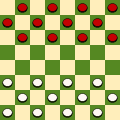
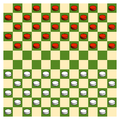
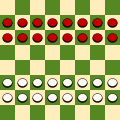

The World Championship in English draughts began in 1840. The winners in men's have been from the United Kingdom, United States, Barbados, and most recently Italy in the 3-Move division. However the women's championship in English draughts is more recent than the women's championship in International draughts and started in 1993. On the women's side the winners have been from Ireland, Turkmenistan, and the Ukraine.
The World Championship in international draughts began in 1885 in France, since 1948 organized by the World Draughts Federation (FMJD, Fédération Mondiale du Jeu de Dames). The championship occurs every two years. In the even year following the tournament must take place the World Title match. The men's championship has had winners from the Netherlands, Canada, the Soviet Union, Senegal, Latvia, and Russia. The first Women's World Championship was held in 1973. Since 1971, was played the World Junior Championship. Also held European Championships - since 1965 (men) and 2000 (women).
The World Championship in Brazilian draughts began in 1985, in Russian draughts began in 1993. First official Turkish draughts World Championships were in 2014.
A similar game has been played for thousands of years. A board resembling a draughts board was found in Ur dating from 3000 BC. In the British Museum are specimens of ancient Egyptian checkerboards, found with their pieces in burial chambers, and the game was played by Queen Hatasu. Plato mentioned a game, πεττεία or petteia, as being of Egyptian origin, and Homer also mentions it. The method of capture was placing two pieces on either side of the opponent's piece. It was said to have been played during the Trojan War. The Romans played a derivation of petteia called latrunculi, or the game of the Little Soldiers.
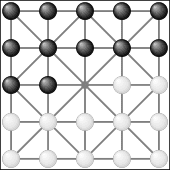 Alquerque board and setup
Alquerque board and setupRead main article: Alquerque
An Arabic game called Quirkat or al-qirq, with similar play to modern draughts, was played on a 5x5 board. It is mentioned in the 10th century work Kitab al-Aghani. Al qirq was also the name for the game that is now called Nine Men's Morris. Al qirq was brought to Spain by the Moors, where it became known as Alquerque, the Spanish derivation of the Arabic name. The rules are given in the 13th century book Libro de los juegos. In about 1100, probably in the south of France, the game of Alquerque was adapted using backgammon pieces on a chessboard. Each piece was called a "fers", the same name as the chess queen, as the move of the two pieces was the same at the time.
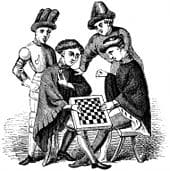 Men in medieval clothing playing draughts
Men in medieval clothing playing draughtsThe rule of crowning was used by the 13th century, as it is mentioned in the Philip Mouskat's Chronique in 1243 when the game was known as Fierges, the name used for the chess queen (derived from the Persian ferz, meaning royal counsellor or vizier). The pieces became known as "dames" when that name was also adopted for the chess queen. The rule forcing players to take whenever possible was introduced in France in around 1535, at which point the game became known as Jeu forcé, identical to modern English draughts. The game without forced capture became known as Le jeu plaisant de dames, the precursor of international draughts.
The 18th-century English author Samuel Johnson wrote a foreword to a 1756 book about draughts by William Payne, the earliest book in English about the game.
English draughts (American 8x8 checkers) has been the arena for several notable advances in game artificial intelligence. In the 1950s, Arthur Samuel created one of the first board game-playing programs of any kind. More recently, in 2007 scientists at the University of Alberta developed their "Chinook" program to the point where it is unbeatable. A brute force approach that took hundreds of computers working nearly two decades was used to solve the game, showing that a game of draughts will always end in a draw if neither player makes a mistake. The solution is for the draughts variation called go-as-you-please (GAYP) checkers and not for the variation called three-move restriction checkers. As of December 2007, this makes English draughts the most complex game ever solved.